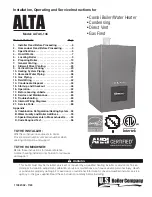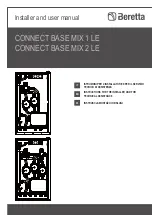
49
Boiler Manual
PART 9. START-UP PREPARATION
To assure good extended service life, it is
recommended that you test your water quality
prior to installation. Listed below are some
guidelines.
A. CHECK/CONTROL WATER CHEMISTRY
Water pH between 6.0 and 8.0
1. Maintain boiler water pH between 6.0 and 8.0.
Check with litmus paper or have it chemically
analyzed by a water treatment company.
2.
If the pH differs from above, consult local water
treatment company for treatment needed.
Hardness less than 7 grains.
1. Consult local water treatment companies for
unusually hard water areas (above 7 grains
hardness).
Chlorine concentration less than 200 ppm
1. Using chlorinated fresh water should be
acceptable since drinking water chlorine
levels are typically less than 5 ppm.
2. Do not connect the boiler to directly heat a
swimming pool or spa water.
3. Do not fill boiler or operate with water
containing chlorine in excess of 200 ppm.
Clean system to remove sediment
1. You must thoroughly flush the system
(without boiler connected) to remove
sediment. The high-efficiency heat exchanger
can be damaged by build up or corrosion due
to sediment build up.
2. For zoned systems, flush each zone sepa-
rately through a purge valve. (If purge valves
and isolation valves are not already installed,
install them to properly clean the system.)
3. Flush system until water runs clean and you
are sure piping is free of sediment.
Test freeze protection fluid
1. For systems using freeze protection fluids,
follow fluid manufacturer’s instructions to
verify inhibitor level and that other fluid
characteristics are satisfactory.
2.
Freeze protection fluid must be replaced period-
ically due to degradation of inhibitors over time.
Follow all fluid manufacturer’s instructions.
B. FREEZE PROTECTION (WHEN USED)
1. Determine the freeze protection fluid quantity
using total system water content, following
fluid manufacturer’s instructions. Remember
to include expansion tank water content.
2. Local codes may require back flow preventer
or actual disconnect from city water supply.
3. When using freeze protection fluid with
automatic fill, install a water meter to monitor
water makeup. Freeze protection fluid may
leak before the water begins to leak, causing
concentration to drop, reducing the freeze
protection level.
C. FILL AND TEST WATER SYSTEM
1. Fill the system only after ensuring the water
meets the requirements of this manual.
2. Close the manual and automatic air vents and
boiler drain valve.
3. Fill to the correct system pressure. Correct
pressure will vary with each application.
a.
Typical cold water fill pressure for a
residential system is 12 psi.
b. Pressure will rise when boiler is turned
on and system water temperature
increases. Operating pressure must
never exceed the relief valve pressure
setting.
n
WARNING
NEVER use automotive or standard glycol
antifreeze. Do not use ethylene glycol made for
hydronic systems. Use only freeze-prevention
fluids certified by fluid manufacturer as suitable
for use with stainless steel boilers, verified in
the fluid manufacturer’s literature.
Thoroughly clean and flush any system that has
has used glycol before installing the new boiler.
Provide the boiler owner with a material safety
data sheet (MSDS) on the fluid used.
n
WARNING
Do not use petroleum-based cleaning or sealing
compounds in the boiler system. Damage to
elastomer seals and gaskets in the system could
occur, resulting in substantial property damage.
Содержание EL-110 LP
Страница 48: ...47 Boiler Manual PART 8 FIELD WIRING CONTINUED Fig 8 5 LP 293 J Rev 10 1 09 ...
Страница 49: ...48 Boiler Manual PART 8 FIELD WIRING CONTINUED Fig 8 5 LP 293 J Rev 1 14 10 ...
Страница 83: ...82 LP 172 REV 2 16 06 ...
Страница 84: ...83 LP 172 REV 2 16 06 ...
Страница 85: ...84 MAINTENANCE NOTES ...
Страница 86: ...85 MAINTENANCE NOTES ...
Страница 87: ...86 MAINTENANCE NOTES ...
Страница 88: ... 2003 2010 Heat Transfer Products Inc www HTproducts com LP 293 REV 01 06 10 ...
















































